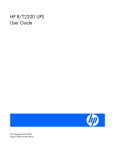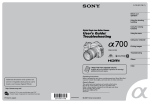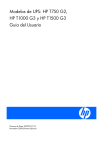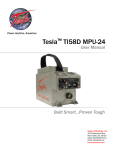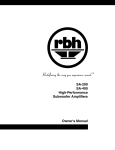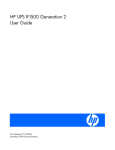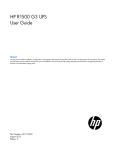Download HP R2200 User's Manual
Transcript
HP R/T2200 UPS
User Guide
October 2006 (Third Edition)
Part Number 404314-003
© Copyright 2006 Hewlett-Packard Development Company, L.P.
The information contained herein is subject to change without notice. The only warranties for HP products and services are set forth in the express
warranty statements accompanying such products and services. Nothing herein should be construed as constituting an additional warranty. HP
shall not be liable for technical or editorial errors or omissions contained herein.
October 2006 (Third Edition)
Part Number 404314-003
Audience assumptions
This guide is for the person who operates, configures, maintains, and troubleshoots UPSs. HP assumes
you are qualified in the servicing of high-voltage equipment and trained in recognizing hazards in
products with hazardous energy levels.
Contents
Component identification ............................................................................................................... 6
UPS
UPS
UPS
UPS
front panel ......................................................................................................................................... 6
front panel controls and LED indicators .................................................................................................. 7
R/T2200 NA/JPN/TWN rear panel..................................................................................................... 8
R/T2200 INTL rear panel .................................................................................................................... 9
REPO port .................................................................................................................................... 10
Installation ................................................................................................................................. 12
Precautions............................................................................................................................................. 12
Preparing to install the hardware............................................................................................................... 12
Required tools ............................................................................................................................... 12
Selecting a site.............................................................................................................................. 13
Readying the equipment ................................................................................................................. 13
Installing the UPS as a tower..................................................................................................................... 13
Installing the UPS in a rack ....................................................................................................................... 18
Connecting the batteries ................................................................................................................. 21
Selecting the UPS voltage configuration............................................................................................ 22
Connecting the host computer ......................................................................................................... 23
Connecting the UPS to utility power ................................................................................................. 26
Connecting devices to the UPS ........................................................................................................ 26
Charging the UPS batteries ............................................................................................................. 27
Powering up the UPS ..................................................................................................................... 27
Installing the ERM as a tower .................................................................................................................... 27
Installing the ERM in a rack ...................................................................................................................... 31
Connecting the ERM to the UPS ....................................................................................................... 33
Attaching the RETMA rail covers...................................................................................................... 34
Charging the ERM batteries ............................................................................................................ 34
UPS operations........................................................................................................................... 35
Initiating a self-test ................................................................................................................................... 35
Silencing an audible alarm....................................................................................................................... 35
Audible alarm conditions................................................................................................................ 35
Setting the power sensitivity adjustment dial................................................................................................ 35
Powering down the UPS ........................................................................................................................... 36
Power management .................................................................................................................... 37
Power management software .................................................................................................................... 37
Maintenance .............................................................................................................................. 38
Updating the UPS firmware ...................................................................................................................... 38
Replacing the batteries............................................................................................................................. 38
Important battery safety information ................................................................................................. 38
Battery care and storage guidelines ................................................................................................. 39
UPS battery replacement procedure ................................................................................................. 39
Cleaning battery spills ............................................................................................................................. 41
Troubleshooting .......................................................................................................................... 42
UPS does not start ................................................................................................................................... 42
UPS does not communicate with the host computer ...................................................................................... 42
UPS firmware updating process is interrupted ............................................................................................. 42
Audible alarm sounds .............................................................................................................................. 42
Circuit breaker trips ................................................................................................................................. 43
Contents
3
UPS operates on battery only .................................................................................................................... 43
UPS frequently switches between utility and battery power............................................................................ 43
UPS does not provide the expected backup time ......................................................................................... 43
UPS emits a slight clicking noise ................................................................................................................ 43
Power LED flashes ................................................................................................................................... 43
Voltage Configuration LED is green ........................................................................................................... 44
Output Load Level LED is red or flashing red ............................................................................................... 44
Battery Charge LED is red......................................................................................................................... 44
Specifications ............................................................................................................................. 45
UPS physical specifications....................................................................................................................... 45
ERM physical specifications ...................................................................................................................... 45
UPS input specifications ........................................................................................................................... 45
UPS output specifications.......................................................................................................................... 46
Power protection specifications ....................................................................................................... 46
Voltage specifications .................................................................................................................... 46
Output tolerance specifications........................................................................................................ 46
Output feature specifications ........................................................................................................... 46
Battery specifications ............................................................................................................................... 47
Battery runtime........................................................................................................................................ 47
Environmental specifications ..................................................................................................................... 47
Spares....................................................................................................................................... 48
Ordering spares...................................................................................................................................... 48
Spare parts list........................................................................................................................................ 48
Hardware options ................................................................................................................................... 48
Technical support........................................................................................................................ 49
Before you contact HP.............................................................................................................................. 49
HP contact information ............................................................................................................................. 49
Warranty information.................................................................................................................. 50
Limited warranty ..................................................................................................................................... 50
$250,000 Computer Load Protection Guarantee......................................................................................... 50
Pre-Failure Battery Warranty ..................................................................................................................... 50
Regulatory compliance notices ..................................................................................................... 52
Regulatory compliance identification numbers ............................................................................................. 52
Federal Communications Commission notice............................................................................................... 52
FCC rating label............................................................................................................................ 52
Class A equipment......................................................................................................................... 53
Class B equipment ......................................................................................................................... 53
Declaration of conformity for products marked with the FCC logo, United States only....................................... 53
Modifications.......................................................................................................................................... 54
Cables ................................................................................................................................................... 54
Canadian notice (Avis Canadien).............................................................................................................. 54
European Union regulatory notice ............................................................................................................. 54
Disposal of waste equipment by users in private households in the European Union ......................................... 55
Japanese notice ...................................................................................................................................... 55
BSMI notice ............................................................................................................................................ 55
Korean notice ......................................................................................................................................... 56
Battery replacement notice........................................................................................................................ 56
Power cord statement for Japan................................................................................................................. 56
Electrostatic discharge ................................................................................................................. 57
Contents
4
Preventing electrostatic discharge .............................................................................................................. 57
Grounding methods to prevent electrostatic discharge .................................................................................. 57
Acronyms and abbreviations........................................................................................................ 58
Index......................................................................................................................................... 59
Contents
5
Component identification
In this section
UPS front panel ........................................................................................................................................ 6
UPS front panel controls and LED indicators ................................................................................................ 7
UPS R/T2200 NA/JPN/TWN rear panel ................................................................................................... 8
UPS R/T2200 INTL rear panel ................................................................................................................... 9
UPS front panel
Item
Description
1
Battery compartment
2
Control buttons and LED display
Component identification 6
UPS front panel controls and LED indicators
Item
Description
Function
1
Power On/Standby
button
Turns the UPS power on and off, and places the UPS in Standby mode.1
2
Power LED
Green—The UPS is on and supplying connected equipment with AC
power.
Flashing green—The UPS is operating from its internal batteries during a
blackout or severe brownout. If the blackout or brownout is prolonged,
save any open files and shut down the connected equipment.
3
Voltage Correction LED
Green—The UPS is automatically correcting high or low AC voltage on
the utility line without the assistance of battery power. The UPS will emit a
slight clicking noise.
4
Output Load Level LED
Shows approximately how much of the UPS power capacity is used to
support the equipment connected to the output receptacles.
Red—Maximum load
Amber—Medium load
Green—Light load
5
Battery Charge LED
When the UPS is operating from utility power (the Power LED is green),
the Battery Charge LED indicates the approximate charge state of the
batteries:
•
Red—The batteries are beginning to charge.
•
Amber—The batteries are midway through charging.
•
Green—The batteries are fully charged.
When the UPS is operating on battery power during a blackout or severe
brownout (the Power LED is flashing green), the Battery Charge LED
indicates the approximate amount of remaining battery energy:
•
Red—The batteries have a low level of energy.
•
Amber—The batteries have a medium amount of energy.
•
Green—The batteries have a high amount of energy.
Periodically initiate a self-test ("Initiating a self-test" on page 35) to
determine the energy level of the batteries before a blackout or brownout
occurs.
Component identification 7
1
Item
Description
Function
6
Battery Warning LED
Red—During a self-test, the UPS found that the batteries must be
recharged. Charge the batteries and repeat the self-test ("Initiating a selftest" on page 35).
7
Mute/Test button
Silences UPS alarms and initiates a self-test ("Initiating a self-test" on
page 35).
IMPORTANT: While in Standby mode, the UPS maintains the charge on the batteries, but no power is
available at the output receptacles. The UPS remains in Standby mode until an alternate mode is selected or
until utility power is removed.
UPS R/T2200 NA/JPN/TWN rear panel
Item
Description
1
Load segment 1 (one NEMA 5-15 output receptacle for
surge and battery backup protection)
2
Load segment 2 (one NEMA 5-15 output receptacle for
surge and battery backup protection)
3
Load segment 3 (one NEMA 5-20 output receptacle for
surge and battery backup protection)
4
Load segment 4 (five unswitchable NEMA 5-15/20 output
receptacles for surge and battery backup protection)
5
Input circuit breaker
6
Input power cord with NEMA 5-20 plug
7
Serial communications port
8
USB communications port
9
REPO port
10
Voltage configuration and charge rate DIP switches
11
Power sensitivity adjustment dial
12
Ground bonding screw
Component identification 8
Item
Description
13
ERM connector
For information about controlling load segments remotely, see "Power management software (on page
37)."
UPS R/T2200 INTL rear panel
Item
Description
1
Load segment 1 (one IEC-320-C13 output receptacle for
surge and battery backup protection)
2
Load segment 2 (one IEC-320-C13 output receptacle for
surge and battery backup protection)
3
Load segment 3 (one IEC-320-C13 output receptacle for
surge and battery backup protection)
4
Load segment 4 (five unswitchable IEC-320-C13 output
receptacles for surge and battery backup protection)
5
Input circuit breaker
6
Input power cord with IEC-320-C20 plug
7
Serial communications port
8
USB communications port
9
REPO port
10
Voltage configuration and charge rate DIP switches
11
Power sensitivity adjustment dial
12
Ground bonding screw
13
ERM connector
For information about controlling load segments remotely, see "Power management software (on page
37)."
Component identification 9
REPO port
The UPS includes an RJ-11 type EPO port. The EPO function can be used to power down the UPS output
receptacles in an emergency. This feature is enabled by utilizing a normally open (N.O.) switch (option 1)
or a normally closed (N.C.) switch (option 2). The EPO port is referred to as a REPO port when used in
conjunction with a remote main disconnect device that shuts down utility power in an emergency.
Option 1: User supplied normally open switch
When the switch is enabled:
•
The REPO feature immediately powers down protected devices and does not utilize the orderly
shutdown procedure initiated by power management software.
•
The REPO feature shuts down UPS units operating under either utility or battery power.
Option 2: User supplied normally closed switch
NOTE: If the UPS was operating on battery power when the remote switch was closed, no power is
available to the load devices until utility power is restored and the UPS has been manually powered up.
Component identification 10
To restore power to the load devices after the REPO feature is activated, press the Power On/Standby
button after the AC source is reconnected to the UPS.
IMPORTANT: Pressing and holding the Power On/Standby button without utility present normally initiates
a battery start and the UPS assumes the load. However, if the Power On/Standby button is pressed and a
REPO is detected, battery start is inhibited and the UPS is not able to assume the load.
To power down the entire network in the event of an emergency, the REPO ports of multiple UPS units can
be connected to a single switch.
Component identification 11
Installation
In this section
Precautions............................................................................................................................................ 12
Preparing to install the hardware ............................................................................................................. 12
Installing the UPS as a tower.................................................................................................................... 13
Installing the UPS in a rack ...................................................................................................................... 18
Installing the ERM as a tower................................................................................................................... 27
Installing the ERM in a rack ..................................................................................................................... 31
Precautions
Save these instructions. This document contains important safety instructions that should be followed
during installation, operation, and maintenance of the UPS and batteries.
WARNING: A risk of personal injury from electric shock and hazardous energy levels
exists. The installation of options and routine maintenance and service of this product
must be performed by individuals who are knowledgeable about the procedures,
precautions, and hazards associated with AC power products.
WARNING: To prevent personal injury from earth conductor leakage current:
• Do not operate the UPS while disconnected from the utility power source.
• Disconnect load devices before disconnecting the UPS from the utility power source.
WARNING: To prevent personal injury, prepare the area and observe all materials
handling procedures when transporting the UPS. When fully assembled, the UPS weighs
29 kg (64 lb).
WARNING: To prevent personal injury, prepare the area and observe all materials
handling procedures when transporting the ERM. When fully assembled, the ERM weighs
28.6 kg (63 lb).
Preparing to install the hardware
Before installing the hardware:
1.
Be sure the necessary tools and materials ("Required tools" on page 12) are available.
2.
Select an installation site ("Selecting a site" on page 13).
3.
Prepare the equipment ("Readying the equipment" on page 13) for installation in the rack.
Required tools
•
No. 2 Phillips screwdriver
•
T-20 Torx screwdriver
Installation 12
Selecting a site
WARNING: To prevent fire or electric shock, install the unit in a temperature- and
humidity-controlled indoor environment, free of conductive contaminants.
When selecting a site, consider the following factors:
•
Elevated operating ambient temperature—If the equipment is installed in a closed or multi-unit rack
assembly, the operating ambient temperature of the rack environment might be greater than room
ambient temperature. Install the equipment in an environment compatible with the operating
temperature ("Environmental specifications" on page 47).
•
Reduced air flow—In the rack, the rate of air flow required for safe operation of the equipment must
not be compromised.
•
Circuit overloading—Consideration should be given to the connection of the equipment to the supply
circuit and the effect that overloading of the circuits might have on overcurrent protection and supply
wiring. Appropriate consideration of equipment nameplate ratings should be used when addressing
this concern.
•
Reliable earthing—Reliable earthing of rack-mounted equipment should be maintained. Particular
attention should be given to supply connections other than direct connections to the branch circuit,
such as the use of power strips.
•
Electrical requirements—All models require a dedicated (unshared) branch circuit, suitably rated for
the specific UPS as stated in "Input specifications ("UPS input specifications" on page 45)" .
Readying the equipment
1.
Check the battery recharge date specified on the label that is affixed to the shipping carton.
IMPORTANT: Do not use the battery if the recharge date has passed. If the date on the battery recharge
date label has passed without the battery being recharged, contact an HP authorized service representative
for directions.
2.
Transport the packaged unit to its installation location.
3.
Unpack the equipment near the rack where the unit will be assembled.
CAUTION: Always plan the rack installation so that the heaviest item is on the bottom of the rack. Install
the heaviest item first, and continue to populate the rack from the bottom to the top.
Installing the UPS as a tower
Before installing the unit, review and adhere to all warnings provided in "Precautions (on page 12)."
Installation 13
1.
Remove the UPS front bezel.
2.
Attach the logo badge above the LED/Control panel.
Installation 14
3.
From inside the bezel, gently push out the LED/Control panel and rotate 90 degrees.
4.
Replace the front bezel.
Installation 15
5.
Stand the unit on its side with the LED/Control panel at the top. Extend the tower stand to fit any
configuration from 1U to 9U.
Installation 16
Installation 17
6.
Adjust the fine adjustment screws to ensure the tower stands fit securely around the UPS and/or
ERM.
Installing the UPS in a rack
Before installing the unit, review and adhere to all warnings provided in "Precautions (on page 12)."
WARNING: To reduce the risk of personal injury or damage to the equipment, be sure
that:
• The leveling feet are extended to the floor.
• The full weight of the rack rests on the leveling feet.
• The stabilizing feet are attached to the rack if it is a single-rack installation.
• The racks are coupled together in multiple-rack installations.
• Only one component is extended at a time. A rack may become unstable if more than
one component is extended for any reason.
NOTE: Mounting hardware for square- and round-holed racks is included in the UPS kit.
Installation 18
1.
Attach the 2U side-mounting brackets to the unit.
2.
Loosen the wing nuts, and extend the brackets to the desired length.
Installation 19
3.
Insert screws through the rack into the mounting rail and the front of each mounting bracket. Do not
completely tighten the screws.
4.
Insert screws through the rack into the mounting rail and the rear of each mounting bracket. Do not
completely tighten the screws.
5.
Wait until the unit is installed and the brackets are adjusted before tightening the screws.
6.
Tighten the wing nuts.
WARNING: Uneven mechanical loading in the rack may cause a hazardous condition.
CAUTION: Always plan the rack installation so that the heaviest item is on the bottom of the rack. Install
the heaviest item first, and continue to populate the rack from the bottom to the top.
7.
With one person on each side, lift the chassis to rail level and slide the chassis on the mounting rails.
8.
Attach the chassis to the rack using the supplied screws.
Installation 20
Connecting the batteries
WARNING: The unit contains sealed lead-acid battery modules. To prevent fire or
chemical burns:
• Do not attempt to recharge batteries after removal from the unit.
• Do not disassemble, crush, or puncture the batteries.
• Do not short the external contacts of the batteries.
• Do not immerse the batteries in water.
• Do not expose to temperatures higher than 40°C (104°F).
WARNING: To prevent personal injury from hazardous energy:
• Remove watches, rings, or other metal objects.
• Use tools with insulated handles.
• Do not place tools or metal parts on top of batteries.
IMPORTANT: Before performing the following tasks, be sure that the unit is powered down and
disconnected from the utility power source.
1.
Remove the UPS front bezel.
Installation 21
2.
Connect the battery lead to the battery terminal.
NOTE: A small amount of arcing may occur when connecting the batteries. This is normal and does not
damage the unit or present any safety concern.
3.
Replace the UPS front bezel.
4.
Attach the RETMA rail covers.
NOTE: The HP logo and product name are printed on the RETMA rail covers; therefore, the HP logo badge
is only used for a tower installation/configuration.
Selecting the UPS voltage configuration
Using a small tool, position the DIP switches according to the desired voltage configuration and charge
rate as identified on the rear panel of the UPS and in the following table.
When using an ERM, set the Battery Charge Level switch (DIP switch 3) to the down position, increasing
the UPS charger output and charging the ERM faster.
Installation 22
CAUTION: Do not set the Battery Charge Level switch to the down position without an ERM connected.
There is a risk of damaging the internal battery system of the UPS.
NOTE: DIP switch 4 is inactive and does not affect UPS operation regardless of the position.
NOTE: An asterisk (*) indicates the default setting.
R/T2200
NA/JPN/TW
N
Output voltage
Input
voltage
range
120 V* (NA)
DIP switch 2
DIP switch 3
DIP switch 4
108–127 V Up
Up
Up*
Up
110 V
99–116 V
Up
Down
—
—
100 V*
(JPN/TWN)
90–106 V
Down
Up
—
—
120 V
108–127 V Down
Down
Down
Down
20–7243 V Up
Up
Up*
Up
230 V* (INTL)
207–243 V Up
Down
—
—
220 V
198–233 V Down
Up
—
—
240 V
216–254 V Down
Down
Down
Down
R/T2200 INTL 230 V
DIP switch 1
Connecting the host computer
CAUTION: Use only the computer interface cable supplied with the UPS to connect the communications
port to the host computer.
CAUTION: Using a USB to serial converter cable will damage the UPS.
Connect the UPS to a host computer using either the USB cable or the DB9 serial cable included with the
UPS. Install HP Power Manager software 4.1 or later on the host computer. See the HP website
(http://www.hp.com/go/rackandpower) to download the latest version of HP Power Manager.
Installation 23
IMPORTANT: If using HPPM, connect the Management Server to an unswitched output receptacle ("UPS
R/T2200 INTL rear panel" on page 9, "UPS R/T2200 NA/JPN/TWN rear panel" on page 8), and then set
the Management Server as the last device to shutdown, ensuring that all connected load devices are
shutdown gracefully.
NOTE: To install and configure the software, see the software user guide. The software user guide is
available for download from the HP website (http://www.hp.com/go/rackandpower).
Connecting the serial communications port
CAUTION: Use only the computer interface cable supplied with the UPS to connect the communications
port to the host computer.
CAUTION: Using a USB to serial converter cable will damage the UPS.
IMPORTANT: Power management software requires the communications port to be appropriately cabled
to the host computer.
Installation 24
Connecting the USB communications port
CAUTION: Using a USB to serial converter cable will damage the UPS.
Connecting the REPO port
WARNING: To meet the requirements stated in NEC (NFPA 70) Articles 645-10 and 64511, a UPS installed in a computer equipment room must be connected to a REPO circuit.
IMPORTANT: The remote switch must be in the Off (open) position to enable power to the output
receptacles.
Installation 25
NOTE: Wire the connector block using stranded, nonshielded wire (AWG #22 - #18, or equivalent).
Connecting the ground bonding cable
The ground bonding screw is provided as an attachment point for conductors. Use a ground bonding
cable if the rack contains any conductors for the purpose of functional grounding or bonding of
ungrounded metal parts.
The ground bonding cable is not included.
Connecting the UPS to utility power
WARNING: To prevent injury from electric shock or damage to the equipment:
• Plug the input line cord into a grounded (earthed) electrical outlet that is installed
near the equipment and is easily accessible.
• Do not disable the grounding plug on the input line cord. The grounding plug is an
important safety feature.
• Do not use extension cords.
1.
Connect the input power cord from an intended load device to the IEC-320-C20 input power
receptacle on the UPS rear panel (INTL model only).
2.
Connect the UPS power cord to a grounded utility power outlet. When the UPS is plugged in, the
batteries begin to charge. Power to the output receptacles designated for surge and battery backup
is not available until the unit is powered up.
For more information about receptacle control, see "Power management software (on page 37)" .
Connecting devices to the UPS
CAUTION: Do not plug laser printers into the UPS output receptacles. The instantaneous current drawn by
this type of printer can overload the UPS.
Before connecting devices, verify that the UPS will not overload by checking that the ratings of the devices
do not exceed the UPS capacity. If the equipment rating is listed in amps, multiply the number of amps by
120 (for Japan, by 100) to determine the VA.
After verifying that the UPS will not overload:
Installation 26
•
Connect the device power cords to the output receptacles on the rear panel of the UPS
(NA/JPN/TWN model).
-or-
•
Connect devices to the output receptacles on the rear panel of the UPS using the jumper cords
included with the UPS (INTL model).
Charging the UPS batteries
Allow the batteries to charge before putting the UPS into service.
IMPORTANT: Charge the batteries for at least 24 hours before supplying backup power to devices. The
batteries charge to:
• 90% of their capacity within 4 hours
• 100% of their capacity within 24 hours
Powering up the UPS
Press and hold the Power On/Standby button until the UPS beeps. The Power LED illuminates solid green,
indicating that power is available at the UPS output receptacles.
Installing the ERM as a tower
Before installing the unit, review and adhere to all warnings provided in "Precautions (on page 12)."
Installation 27
1.
Attach the logo badge above the LED/Control panel.
Installation 28
2.
Stand the unit on its side with the LED/Control panel at the top. Extend the tower stand to fit any
configuration from 1U to 9U.
Installation 29
Installation 30
3.
Adjust the fine adjustment screws to ensure the tower stands fit securely around the UPS and/or
ERM.
Installing the ERM in a rack
Before installing the unit, review and adhere to all warnings provided in "Precautions (on page 12)."
WARNING: To reduce the risk of personal injury or damage to the equipment, be sure
that:
• The leveling feet are extended to the floor.
• The full weight of the rack rests on the leveling feet.
• The stabilizing feet are attached to the rack if it is a single-rack installation.
• The racks are coupled together in multiple-rack installations.
• Only one component is extended at a time. A rack may become unstable if more than
one component is extended for any reason.
NOTE: Mounting hardware for square- and round-holed racks is included in the UPS kit.
Installation 31
1.
Attach the 2U side-mounting brackets to the unit.
2.
Loosen the wing nuts, and extend the brackets to the desired length.
Installation 32
3.
Insert screws through the rack into the mounting rail and the front of each mounting bracket. Do not
tighten.
4.
Insert screws through the rack into the mounting rail and the rear of each mounting bracket. Do not
tighten.
5.
Tighten the wing nuts.
6.
Wait until the unit is installed and the brackets are adjusted before tightening the screws.
WARNING: Uneven mechanical loading in the rack may cause a hazardous condition.
CAUTION: Always plan the rack installation so that the heaviest item is on the bottom of the rack. Install
the heaviest item first, and continue to populate the rack from the bottom to the top.
7.
With one person on each side, lift the chassis to rail level and slide the chassis on the mounting rails.
8.
Attach the chassis to the rack using the supplied screws.
Connecting the ERM to the UPS
Installation 33
This symbol indicates the presence of electric shock hazards. The area contains no
user or field serviceable parts. Do not open for any reason.
WARNING: To reduce the risk of injury from electric shock hazards, do not open
this enclosure.
Plug the ERM cable into the socket at the rear of the UPS.
Attaching the RETMA rail covers
NOTE: The HP logo and product name are printed on the RETMA rail covers; therefore, the HP logo badge
is only used for a tower installation/configuration.
Charging the ERM batteries
Connect the UPS to a grounded utility power outlet. When the UPS is plugged in, the unit automatically
enters Standby mode and begins charging the ERM batteries. Allow 24 hours for the ERM to fully charge.
Installation 34
UPS operations
In this section
Initiating a self-test .................................................................................................................................. 35
Silencing an audible alarm...................................................................................................................... 35
Setting the power sensitivity adjustment dial .............................................................................................. 35
Powering down the UPS.......................................................................................................................... 36
Initiating a self-test
A self-test can be performed with equipment connected to the UPS output receptacles. To initiate a self-test,
press and hold the Mute/Test button until the alarm beeps two times.
CAUTION: Do not unplug the UPS to test the batteries. This action removes safe electrical grounding and
can introduce a damaging surge into the network connections.
The self-test lasts approximately 10 seconds as the UPS switches to battery power to test the load capacity
and battery charge. During the self-test, the Power LED flashes, the Output Load Level LED illuminates, and
the Battery Charge LED illuminates.
Silencing an audible alarm
Press the Mute/Test button.
IMPORTANT:
• Although the audible alarm silences, the condition that caused the alarm to sound might still exist.
• If a utility power failure caused the alarm (the Power LED is flashing green), the alarm silences after
power is restored.
Audible alarm conditions
Alarm type
Condition
Audible alarm
Can alarm be
silenced?
Normal
UPS operating from utility power
No audible alarm
N/A
UPS on battery
UPS operating on battery power
On–four short beeps
Yes
Shutdown imminent
Batteries nearly out of power
On–continuous
Yes
Battery problem
Batteries must be recharged
On–intermittent beeps
Yes
Overload
UPS power capacity exceeded
On–continuous
Yes
Setting the power sensitivity adjustment dial
The power sensitivity adjustment dial is normally set in the counter-clockwise position, enabling the UPS to
provide maximum protection against waveform distortions in the AC input. When distortion occurs, the
UPS operations 35
UPS provides sine wave power from the battery reserves for as long as the distortion is present. In areas
with poor utility power or where the UPS input power comes from a backup generator, continuous
waveform distortion causes the UPS to switch to battery power. To minimize battery use, experiment with
different settings for this dial. As the dial is turned clockwise, the UPS becomes more tolerant of variations
in the input power's AC waveform.
NOTE: While testing, operate connected equipment in a safe test mode so the effects do not disrupt critical
operations.
For the location of rear panel components, see "UPS R/T2200 NA/JPN/TWN rear panel (on page 8)"
or "UPS R/T2200 INTL rear panel (on page 9)."
Powering down the UPS
1.
Shut down all connected load devices.
2.
Press the Power On/Standby button. Power to the output receptacles ceases.
3.
Disconnect the UPS from utility power.
4.
Wait at least 60 seconds for the UPS internal circuitry to discharge.
UPS operations 36
Power management
In this section
Power management software................................................................................................................... 37
Power management software
HP Power Manager software ensures maximum power reliability of computer systems through
comprehensive control of UPSs. The easy-to-use browser interface enables novice users to configure and
manage power protection settings. To download the latest version of HP Power Manager software, see
the HP website (http://www.hp.com/go/rackandpower).
NOTE: To install and configure the software, see the software user guide. The software user guide is
available for download from the HP website (http://www.hp.com/go/rackandpower).
HP Power Manager:
•
Does not require complex management systems, which simplifies deployment, configuration, and
management of UPS-protected environments.
•
Manages a graceful shutdown of attached devices during utility power failures.
•
Prioritizes the timing of attached load device shutdowns.
•
Shuts down and reboots any UPS and attached load devices based on a user-specified schedule.
•
Customizes alert generation with modifiable dialog boxes, command execution, and email and
broadcast messages.
•
Monitors the status of the UPS and reports alarms.
•
Displays a power log for analysis.
•
Manages independent UPS load segments to provide separate control of attached load devices.
Power management 37
Maintenance
In this section
Updating the UPS firmware ..................................................................................................................... 38
Replacing the batteries............................................................................................................................ 38
Cleaning battery spills ............................................................................................................................ 41
Updating the UPS firmware
To update the UPS firmware, see the HP website (http://www.hp.com/go/rackandpower).
CAUTION: Using a USB to serial converter cable will damage the UPS.
NOTE: Be sure to disconnect the USB communications port before beginning the firmware update. Once
the upgrade is complete, reconnect the USB communications port.
NOTE: If the firmware update process is disrupted by disconnecting the serial communications port, restart
the update.
Replacing the batteries
To replace the batteries:
1.
Read and observe the requirements in "Important battery safety information" and "Battery care and
storage guidelines (on page 39)."
2.
Follow the instructions in "UPS battery replacement procedure (on page 39)."
Important battery safety information
WARNING: The unit contains sealed lead-acid battery modules. To prevent fire or
chemical burns:
• Do not attempt to recharge batteries after removal from the unit.
• Do not disassemble, crush, or puncture the batteries.
• Do not short the external contacts of the batteries.
• Do not immerse the batteries in water.
• Do not expose to temperatures higher than 60°C (140°F).
WARNING: To prevent personal injury from hazardous energy:
• Remove watches, rings, or other metal objects.
• Use tools with insulated handles.
• Do not place tools or metal parts on top of batteries.
NOTE: Replace all battery modules at the same time.
Maintenance
38
Battery care and storage guidelines
CAUTION: Because of the short shelf life of the batteries, avoid storing a battery spare as a backup. Do
not maintain an inventory of spare batteries on site unless a procedure to keep these batteries charged while
in storage is implemented.
To maintain the batteries:
•
Minimize the amount of time the UPS uses battery power by matching the UPS configuration with the
utility voltage. See "Selecting the UPS voltage configuration (on page 22)."
•
Keep the area around the UPS clean and dust-free. If the environment is very dusty, clean the outside
of the UPS regularly with a vacuum cleaner.
•
Maintain the ambient temperature at 25°C (77°F).
•
If storing a UPS for an extended period, recharge the batteries ("Charging the UPS batteries" on
page 27) every 6 months, and then update the battery recharge date label.
UPS battery replacement procedure
This component is hot-swappable and can be replaced without powering down the UPS.
1.
(optional) To replace the component with the UPS powered down, refer to "Powering down the UPS
(on page 36)."
CAUTION: When hot-swapping batteries, the UPS is not protected in the event of a utility power failure,
unless an ERM is installed.
2.
Remove the UPS front bezel.
Maintenance
39
3.
Disconnect the battery leads.
4.
Remove the battery bracket.
5.
Remove the UPS battery modules.
Maintenance
40
IMPORTANT: Do not pull the battery leads when removing or installing the batteries.
To replace the component, reverse the removal procedure.
IMPORTANT: Charge the batteries for at least 24 hours before supplying backup power to devices. The
batteries charge to:
• 90% of their capacity within 4 hours
• 100% of their capacity within 24 hours
Cleaning battery spills
1.
Put on acid-resistant boots, a chemical face shield, chemical splash goggles, and acid-resistant
gloves.
WARNING: Battery acid can severely damage your eyes and skin.
2.
Remove combustible materials and all sources of ignition.
3.
Stop the flow of material and contain or absorb small spills with dry sand, earth, or vermiculite.
4.
Neutralize spilled battery acid with the special solutions contained in a spill kit or with a solution of
1 lb baking soda to 1 gallon of water.
5.
Be sure the mixture is neutral, then collect the residue and place the residue in a drum or other
suitable container.
6.
Properly dispose of hazardous waste.
WARNING: Do not allow discharge of unneutralized acid to reach the sewer.
Maintenance
41
Troubleshooting
In this section
UPS does not start .................................................................................................................................. 42
UPS does not communicate with the host computer..................................................................................... 42
UPS firmware updating process is interrupted ............................................................................................ 42
Audible alarm sounds ............................................................................................................................. 42
Circuit breaker trips ................................................................................................................................ 43
UPS operates on battery only................................................................................................................... 43
UPS frequently switches between utility and battery power .......................................................................... 43
UPS does not provide the expected backup time ........................................................................................ 43
UPS emits a slight clicking noise............................................................................................................... 43
Power LED flashes .................................................................................................................................. 43
Voltage Configuration LED is green .......................................................................................................... 44
Output Load Level LED is red or flashing red.............................................................................................. 44
Battery Charge LED is red ....................................................................................................................... 44
UPS does not start
Action:
1.
Be sure that the power cord is plugged in to a utility power receptacle.
2.
Check the power source at the utility power receptacle.
3.
Allow the UPS batteries to charge for 24 hours.
UPS does not communicate with the host computer
Action:
Be sure the USB communications port was disconnected before updating the UPS firmware (on page 38).
CAUTION: Using a USB to serial converter cable will damage the UPS.
UPS firmware updating process is interrupted
The serial communications port is disconnected while updating the UPS firmware (on page 38).
Action:
Restart the update.
Audible alarm sounds
Action:
1.
Identify the red LED associated with the audible alarm.
Troubleshooting 42
2.
Check the troubleshooting information in this document to determine the cause of the alarm.
Circuit breaker trips
Action:
Remove some of the load, and then press the circuit breaker to reset the load.
UPS operates on battery only
Action:
1.
Save your work.
2.
Power down the load devices connected to the UPS output receptacles.
3.
Remove one or more load devices to reduce the power requirements.
4.
Be sure the UPS configuration matches the utility voltage. Refer to "Selecting the UPS voltage
configuration (on page 22)."
UPS frequently switches between utility and battery power
Action:
1.
Check the input voltage.
2.
Change the power sensitivity adjustment dial ("Setting the power sensitivity adjustment dial" on page
35) setting.
3.
Contact a qualified electrician to verify that the utility power is suitable for the UPS.
UPS does not provide the expected backup time
Action:
1.
If the Output Load Level LED is red or flashing red, remove one or more load devices to reduce the
power requirements.
2.
Power down the UPS ("Powering down the UPS" on page 36).
3.
Verify that the batteries are connected.
4.
Allow the UPS batteries to charge for 24 hours.
5.
Initiate a self-test ("Initiating a self-test" on page 35).
6.
During extended power outages, save your work, power down the load devices, and then power
down the UPS ("Powering down the UPS" on page 36) to conserve battery power.
UPS emits a slight clicking noise
Action: The UPS is automatically correcting high or low AC voltage on the utility line. No action is
required.
Power LED flashes
Action:
Troubleshooting 43
If the Battery Charge LED is also red:
a. Save your work, and power down the UPS ("Powering down the UPS" on page 36).
b. After the blackout or brownout is over, power up the UPS ("Powering up the UPS" on page 27).
c. Allow the UPS batteries to charge for 24 hours.
If the Battery Charge LED is also yellow or green:
a. Consider saving your work and powering down the UPS (on page 36). If the blackout or
brownout is prolonged, the Battery Charge LED turns red as the UPS batteries near depletion.
b. After the blackout or brownout is over, power up the UPS ("Powering up the UPS" on page 27).
c. Allow the UPS batteries to charge for 24 hours.
Voltage Configuration LED is green
Action: The UPS is automatically correcting high or low AC voltage on the utility line. No action is
required.
Output Load Level LED is red or flashing red
Action:
1.
Remove one or more load devices to reduce the power requirements.
2.
Initiate a self-test ("Initiating a self-test" on page 35).
3.
If the condition persists, verify that the load devices are not defective.
Battery Charge LED is red
Action:
If the Power LED is flashing green:
a. Save your work, and power down the UPS ("Powering down the UPS" on page 36).
b. After the blackout or brownout is over, power up the UPS ("Powering up the UPS" on page 27).
c. Allow the UPS batteries to charge for 24 hours.
If the Power LED is green:
a. Continue to let the batteries charge until the Battery Charge LED is green.
b. Initiate a self-test ("Initiating a self-test" on page 35).
Troubleshooting 44
Specifications
In this section
UPS physical specifications...................................................................................................................... 45
ERM physical specifications..................................................................................................................... 45
UPS input specifications .......................................................................................................................... 45
UPS output specifications......................................................................................................................... 46
Battery specifications .............................................................................................................................. 47
Battery runtime....................................................................................................................................... 47
Environmental specifications .................................................................................................................... 47
UPS physical specifications
Parameter
Value
Height
8.9 cm (3.5 in)
Depth
48.3 cm (19 in)
Width
44.5 cm (17.5 in)
Weight
29 kg (64 lb)
ERM physical specifications
Parameter
Value
Height
8.9 cm (3.5 in)
Depth
34.3 cm (13.5 in)
Width
44.5 cm (17.5 in)
Weight
28.6 kg (63 lb)
UPS input specifications
NOTE: An asterisk (*) indicates the default setting.
UPS model
Utility voltage
frequency (Hz)
Available settings utility Branch circuit
voltage (VAC)
rating (A)
Line cord
R/T2200
NA/JPN/TWN
50/60
100, 110, 120*
20
Nondetachable power
cord with NEMA 5-20
plug
R/T2200 INTL
50/60
220, 230*, 240
15
Detachable power cord
with IEC-320-C20 plug
Specifications
45
UPS output specifications
UPS model
Output receptacles
Maximum current
R/T2200
NA/JPN/TWN
4 x NEMA 5-15R, 4 x NEMA 515/20R
18.3 A
R/T2200 INTL
8 x IEC-320-C13
9.5 A
Power protection specifications
UPS model
VA
Nominal power
rating (W)
Nominal voltage setting
R/T2200
NA/JPN/TWN
2200
1600
100, 110, 120
R/T2200 INTL
2200
1600
220, 230, 240
Voltage specifications
Configuration setting (VAC)
Available nominal output voltage (VAC)
100
100
110
110
120
120
220
220
230
230
240
240
Output tolerance specifications
Source of power
Regulation
Utility power (nominal
range)
-10% to +6% of nominal output voltage rating (within
the guidelines of the Computer Business Equipment
Manufacturers Association)
Battery power
±10% of nominal output voltage rating
Output feature specifications
Feature
Specification
Online efficiency
95% nominal input voltage
Voltage wave shape
Sine wave; 5% THD with typical PFC load
Surge suppression
High-energy 6500 A peak
Noise filtering
MOVs and line filter for normal and common mode use
Specifications
46
Battery specifications
Feature
Specification
Type
12 V, 9 AH, sealed, maintenance-free, rechargeable, lead-acid
battery
Voltage
The battery modules have a battery string voltage of 48 V.
Charging
Complete charge takes no more than 24 hours. After
approximately 4 hours, the batteries reach 90% charge at
default nominal utility voltage and no load.
Battery runtime
Load, percent
Load, watts
Estimated battery runtime
Runtime with an ERM
20
50
100
45 minutes
150 minutes
250
15 minutes
60 minutes
80
400
8.5 minutes
30 minutes
100
500
6 minutes
20 minutes
Environmental specifications
Feature
Specification
Operating temperature
0°C to 40°C (32°F to 104°F)
Nonoperating temperature -15°C to 50°C (5°F to 122°F)
Relative humidity
0% to 95%; noncondensing
Operating altitude
Up to 2,000 m (6,600 ft) above sea level
Nonoperating altitude
Up to 15,000 m (49,212 ft) above sea level
Audible noise
Less than 53 dBA
Specifications
47
Spares
In this section
Ordering spares..................................................................................................................................... 48
Spare parts list....................................................................................................................................... 48
Hardware options .................................................................................................................................. 48
Ordering spares
To order a spare, visit the HP website (http://h61003.www6.hp.com).
To replace parts under warranty, contact an HP authorized service representative.
Spare parts list
Item
Spare part number
UPS unit NA
410039-001
UPS unit JPN/TWN
410040-291
UPS unit INTL
410041-B31
ERM unit
410045-001
UPS/ERM tower stand
410042-001
UPS/ERM mounting hardware
415694-001
UPS battery
416727-001
Hardware options
For information on the supported hardware options, see the HP website
(http://www.hp.com/go/rackandpower).
Spares 48
Technical support
In this section
Before you contact HP............................................................................................................................. 49
HP contact information............................................................................................................................ 49
Before you contact HP
Be sure to have the following information available before you call HP:
•
Technical support registration number (if applicable)
•
Product serial number
•
Product model name and number
•
Applicable error messages
•
Add-on boards or hardware
•
Third-party hardware or software
•
Operating system type and revision level
HP contact information
For the name of the nearest HP authorized reseller:
•
In the United States, see the HP US service locator webpage (http://www.hp.com/service_locator).
•
In other locations, see the Contact HP worldwide (in English) webpage
(http://welcome.hp.com/country/us/en/wwcontact.html).
For HP technical support:
•
•
In the United States, for contact options see the Contact HP United States webpage
(http://welcome.hp.com/country/us/en/contact_us.html). To contact HP by phone:
•
Call 1-800-HP-INVENT (1-800-474-6836). This service is available 24 hours a day, 7 days a
week. For continuous quality improvement, calls may be recorded or monitored.
•
If you have purchased a Care Pack (service upgrade), call 1-800-633-3600. For more
information about Care Packs, refer to the HP website (http://www.hp.com).
In other locations, see the Contact HP worldwide (in English) webpage
(http://welcome.hp.com/country/us/en/wwcontact.html).
Technical support 49
Warranty information
In this section
Limited warranty .................................................................................................................................... 50
$250,000 Computer Load Protection Guarantee ....................................................................................... 50
Pre-Failure Battery Warranty.................................................................................................................... 50
Limited warranty
To back up the wide range of features offered with the UPS, a 3-year limited warranty is provided.
$250,000 Computer Load Protection Guarantee
In addition to the limited warranty, a $250,000 Computer Load Protection Guarantee (provided by the
original equipment manufacturer) is offered.
IMPORTANT: The $250,000 Computer Load Protection Guarantee is offered only in The United States
and Canada.
The $250,000 Computer Load Protection Guarantee only applies if:
•
The UPS is plugged into a suitably grounded and wired outlet using no extension cords, adapters,
other ground wires, or other electrical connections.
•
The UPS installation complies with all applicable electrical and safety codes specified by the NEC.
•
The UPS is used under normal operating conditions and users comply with all instructions and labels.
•
The UPS is not damaged by accident (other than a utility power transient), misuse, or abuse.
•
•
The Guarantee applies only to the original end-user and is non-transferable.
•
The Guarantee does not include reimbursement for or restoration of any data loss.
The UPS is either connected directly to an enterprise class PDU, which is then connected directly to a
server, workstation, or personal computer, or the UPS is connected directly to a server, workstation,
or personal computer.
Pre-Failure Battery Warranty
The Pre-Failure Battery Warranty, standard on all UPS units, extends the advantage of a 3-year limited
warranty by applying it to the battery before it actually fails. The Pre-Failure Battery Warranty ensures that
the battery is replaced free of charge when a notification that the battery might fail is received from
power management software. The battery warranty coverage is 3 years for parts. The warranty for the
first year of ownership includes parts and labor. If battery spares are not available for a particular UPS
model, the entire UPS, including its battery, is replaced.
A Pre-Failure Battery warning is given 30 days before a battery failure. The warning is indicated in one or
both of the following ways:
•
An LED showing the battery is low
Warranty information 50
•
Notification from power management software
Warranty information 51
Regulatory compliance notices
In this section
Regulatory compliance identification numbers ........................................................................................... 52
Federal Communications Commission notice ............................................................................................. 52
Declaration of conformity for products marked with the FCC logo, United States only..................................... 53
Modifications......................................................................................................................................... 54
Cables .................................................................................................................................................. 54
Canadian notice (Avis Canadien) ............................................................................................................ 54
European Union regulatory notice ............................................................................................................ 54
Disposal of waste equipment by users in private households in the European Union....................................... 55
Japanese notice ..................................................................................................................................... 55
BSMI notice ........................................................................................................................................... 55
Korean notice ........................................................................................................................................ 56
Battery replacement notice ...................................................................................................................... 56
Power cord statement for Japan ............................................................................................................... 56
Regulatory compliance identification numbers
For the purpose of regulatory compliance certifications and identification, this product has been assigned
a unique regulatory model number. The regulatory model number can be found on the product nameplate
label, along with all required approval markings and information. When requesting compliance
information for this product, always refer to this regulatory model number. The regulatory model number is
not the marketing name or model number of the product.
Federal Communications Commission notice
Part 15 of the Federal Communications Commission (FCC) Rules and Regulations has established Radio
Frequency (RF) emission limits to provide an interference-free radio frequency spectrum. Many electronic
devices, including computers, generate RF energy incidental to their intended function and are, therefore,
covered by these rules. These rules place computers and related peripheral devices into two classes, A
and B, depending upon their intended installation. Class A devices are those that may reasonably be
expected to be installed in a business or commercial environment. Class B devices are those that may
reasonably be expected to be installed in a residential environment (for example, personal computers).
The FCC requires devices in both classes to bear a label indicating the interference potential of the device
as well as additional operating instructions for the user.
FCC rating label
The FCC rating label on the device shows the classification (A or B) of the equipment. Class B devices
have an FCC logo or ID on the label. Class A devices do not have an FCC logo or ID on the label. After
you determine the class of the device, refer to the corresponding statement.
Regulatory compliance notices
52
Class A equipment
This equipment has been tested and found to comply with the limits for a Class A digital device, pursuant
to Part 15 of the FCC Rules. These limits are designed to provide reasonable protection against harmful
interference when the equipment is operated in a commercial environment. This equipment generates,
uses, and can radiate radio frequency energy and, if not installed and used in accordance with the
instructions, may cause harmful interference to radio communications. Operation of this equipment in a
residential area is likely to cause harmful interference, in which case the user will be required to correct
the interference at personal expense.
Class B equipment
This equipment has been tested and found to comply with the limits for a Class B digital device, pursuant
to Part 15 of the FCC Rules. These limits are designed to provide reasonable protection against harmful
interference in a residential installation. This equipment generates, uses, and can radiate radio frequency
energy and, if not installed and used in accordance with the instructions, may cause harmful interference
to radio communications. However, there is no guarantee that interference will not occur in a particular
installation. If this equipment does cause harmful interference to radio or television reception, which can
be determined by turning the equipment off and on, the user is encouraged to try to correct the
interference by one or more of the following measures:
•
Reorient or relocate the receiving antenna.
•
Increase the separation between the equipment and receiver.
•
Connect the equipment into an outlet on a circuit that is different from that to which the receiver is
connected.
•
Consult the dealer or an experienced radio or television technician for help.
Declaration of conformity for products marked with the
FCC logo, United States only
This device complies with Part 15 of the FCC Rules. Operation is subject to the following two conditions:
(1) this device may not cause harmful interference, and (2) this device must accept any interference
received, including interference that may cause undesired operation.
For questions regarding this product, contact us by mail or telephone:
•
Hewlett-Packard Company
P. O. Box 692000, Mail Stop 530113
Houston, Texas 77269-2000
•
1-800-HP-INVENT (1-800-474-6836). (For continuous quality improvement, calls may be recorded
or monitored.)
For questions regarding this FCC declaration, contact us by mail or telephone:
•
Hewlett-Packard Company
P. O. Box 692000, Mail Stop 510101
Houston, Texas 77269-2000
•
1281-514-3333
To identify this product, refer to the part, series, or model number found on the product.
Regulatory compliance notices
53
Modifications
The FCC requires the user to be notified that any changes or modifications made to this device that are
not expressly approved by Hewlett-Packard Company may void the user’s authority to operate the
equipment.
Cables
Connections to this device must be made with shielded cables with metallic RFI/EMI connector hoods in
order to maintain compliance with FCC Rules and Regulations.
Canadian notice (Avis Canadien)
Class A equipment
This Class A digital apparatus meets all requirements of the Canadian Interference-Causing Equipment
Regulations.
Cet appareil numérique de la classe A respecte toutes les exigences du Règlement sur le matériel
brouilleur du Canada.
Class B equipment
This Class B digital apparatus meets all requirements of the Canadian Interference-Causing Equipment
Regulations.
Cet appareil numérique de la classe B respecte toutes les exigences du Règlement sur le matériel
brouilleur du Canada.
European Union regulatory notice
This product complies with the following EU Directives:
•
Low Voltage Directive 73/23/EEC
•
EMC Directive 89/336/EEC
Compliance with these directives implies conformity to applicable harmonized European standards
(European Norms) which are listed on the EU Declaration of Conformity issued by Hewlett-Packard for this
product or product family.
This compliance is indicated by the following conformity marking placed on the product:
This marking is valid for non-Telecom products and EU harmonized Telecom products (e.g. Bluetooth).
This marking is valid for EU non-harmonized Telecom products.
*Notified body number (used only if applicable—refer to the product label)
Hewlett-Packard GmbH, HQ-TRE, Herrenberger Strasse 140, 71034 Boeblingen, Germany
Regulatory compliance notices
54
Disposal of waste equipment by users in private
households in the European Union
This symbol on the product or on its packaging indicates that this product must not be
disposed of with your other household waste. Instead, it is your responsibility to dispose of
your waste equipment by handing it over to a designated collection point for the recycling of
waste electrical and electronic equipment. The separate collection and recycling of your
waste equipment at the time of disposal will help to conserve natural resources and ensure
that it is recycled in a manner that protects human health and the environment. For more
information about where you can drop off your waste equipment for recycling, please
contact your local city office, your household waste disposal service or the shop where you
purchased the product.
Japanese notice
BSMI notice
Regulatory compliance notices
55
Korean notice
Class A equipment
Class B equipment
Battery replacement notice
WARNING: Power products contain sealed lead-acid battery modules. A risk of fire and
burns exists if the battery is not properly handled. To reduce the risk of personal injury:
• Do not attempt to recharge the battery.
• Do not expose the battery to temperatures higher than 60°C (140°F).
• Do not disassemble, crush, puncture, short external contacts, or dispose of in fire or
water. The battery might explode.
Batteries, battery packs, and accumulators should not be disposed of together with the
general household waste. To forward them to recycling or proper disposal, use the
public collection system or return them to HP, an authorized HP Partner, or their
agents.
For more information about battery replacement or proper disposal, contact an authorized reseller or an
authorized service provider.
Power cord statement for Japan
Regulatory compliance notices
56
Electrostatic discharge
In this section
Preventing electrostatic discharge............................................................................................................. 57
Grounding methods to prevent electrostatic discharge ................................................................................ 57
Preventing electrostatic discharge
To prevent damaging the system, be aware of the precautions you need to follow when setting up the
system or handling parts. A discharge of static electricity from a finger or other conductor may damage
system boards or other static-sensitive devices. This type of damage may reduce the life expectancy of the
device.
To prevent electrostatic damage:
•
Avoid hand contact by transporting and storing products in static-safe containers.
•
Keep electrostatic-sensitive parts in their containers until they arrive at static-free workstations.
•
Place parts on a grounded surface before removing them from their containers.
•
Avoid touching pins, leads, or circuitry.
•
Always be properly grounded when touching a static-sensitive component or assembly.
Grounding methods to prevent electrostatic discharge
Several methods are used for grounding. Use one or more of the following methods when handling or
installing electrostatic-sensitive parts:
•
Use a wrist strap connected by a ground cord to a grounded workstation or computer chassis. Wrist
straps are flexible straps with a minimum of 1 megohm ±10 percent resistance in the ground cords.
To provide proper ground, wear the strap snug against the skin.
•
Use heel straps, toe straps, or boot straps at standing workstations. Wear the straps on both feet
when standing on conductive floors or dissipating floor mats.
•
Use conductive field service tools.
•
Use a portable field service kit with a folding static-dissipating work mat.
If you do not have any of the suggested equipment for proper grounding, have an authorized reseller
install the part.
For more information on static electricity or assistance with product installation, contact an authorized
reseller.
Electrostatic discharge 57
Acronyms and abbreviations
EPO
emergency power off
ERM
extended runtime module
HPPM
Hewlett-Packard Power Manager
IEC
International Electrotechnical Commission
LED
light-emitting diode
NEC
National Electrical Code
NEMA
National Electrical Manufacturers Association
PFC
power factor corrected
REPO
remote emergency power off
RETMA
Radio Electronics Television Manufactures Association (rack spacing)
UPS
uninterruptible power system
USB
universal serial bus
Acronyms and abbreviations
58
Index
A
D
alarm conditions 35
alarms, silencing 35
authorized reseller 49
diagnostics 35
dimensions, ERM 45
dimensions, UPS 45
DIP switches, location 8, 9
DIP switches, setting 22
disposal, battery 56
B
backup time, insufficient 43
batteries, care and storage 39
batteries, charging 27, 34
batteries, cleaning spills 41
batteries, connecting 21
batteries, replacing 38, 39
batteries, runtime 47
batteries, specifications 47
battery cables, connecting 21
Battery Charge LED, location 7
Battery Charge LED, troubleshooting 44
battery replacement notice 56
Battery Warning LED, location 7
battery warranty 50
bezel, front 6
bezel, removing 13, 39
BSMI notice 55
C
cables 54
cables, battery 21
cabling, USB 25
Canadian notice 54
charging batteries 27, 34
circuit breaker, troubleshooting 43
circuit breakers, location 8, 9
class A equipment 53
class B equipment 53
communications port, connecting 24
component identification 6, 7, 8, 9
components, rear 8, 9
configuring components 22
connecting batteries 21
contacting HP 49
E
electrostatic discharge 57
environmental specifications 47
ERM, connecting 33
ERM, R/T2200 27
F
FCC rating label 52
Federal Communications Commission (FCC)
notice 52, 53, 54
frequent switching between battery and utility
power 43
front bezel 6
front panel buttons 7
front panel components 6, 7
front panel LEDs 7
G
ground bonding cable, connecting 26
ground bonding screw, location 8, 9
grounding methods 57
H
hardware options 48
HP technical support 49
I
input circuit breaker, location 8, 9
input specifications 45
installation instructions 12, 13
installing the ERM 13
Index 59
installing the UPS 13
insufficient backup time 43
International model 9
J
Japanese notice 55
K
Korean notices 56
L
LED, power button 7
LEDs 6, 7
LEDs, troubleshooting 42
limited warranty 50
load protection guarantee 50
load segments, location 8, 9
low-voltage UPS 8
M
maintenance 38
models, high-voltage UPS 9
models, low-voltage UPS 8
modifications, FCC notice 54
Mute/Test button 7
N
nominal voltage, configuring 22
North America and Japan model 8
O
On button, location 7
operations, UPS 35
ordering spares 48
output feature specifications 46
Output Load Level LED, location 7
Output Load Level LED, troubleshooting 44
output specifications 46
output tolerance specifications 46
overview, front panel display 7
overview, REPO port 10
P
power management 37
Power On/Standby button 7
power protection specifications 46
power sensitivity adjustment dial, location 8, 9
power sensitivity adjustment dial, setting 35
powering down 36
powering up 27
problem diagnosis 42
R
R/T2200 INTL 7, 9
R/T2200 NA/JPN/TWN 7, 8
rack-to-tower conversion 13
rear panel components 8, 9
regulatory compliance identification numbers 52
regulatory compliance notices 52, 54, 55
replacing the batteries 38, 39
REPO port, connecting 25
REPO port, overview 10
required information 49
required tools 12
resetting the circuit breaker 8, 10, 43
runtime specifications 47
S
safety considerations 12
selecting a site 13
serial port 24
series number 52
spare part numbers 48
spares 48
specifications 45
Standby button, location 7
Standby mode 7
static electricity 57
storing batteries 39
supported hardware 48
T
technical support 49
telephone numbers 49
temperature ranges (environmental) 47
testing LEDs 35
tower to rack conversion 13
troubleshooting 42
phone numbers 49
physical specifications 45
power LED, location 7
Power LED, troubleshooting 43
Index 60
U
Uninterruptible Power System, high-voltage
models 9
Uninterruptible Power System, low-voltage models 8
UPS does not start 42
UPS operations 35
UPS, installing 12, 13
USB connectors 25
V
Voltage Correction LED, location 7
Voltage Correction LED, troubleshooting 44
voltage specifications 46
voltage, configuring 22
W
warranties 50
weight, ERM 45
weight, UPS 45
Index 61





























































